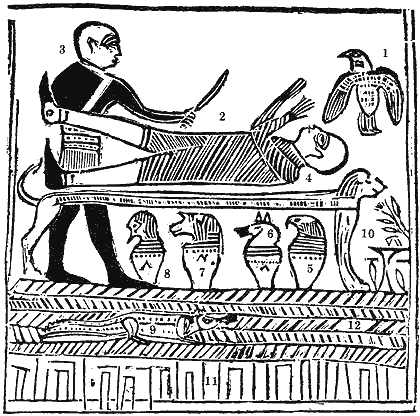
설명
- 그림1. 주의 천사.
- 그림2. 제단 위에 묶인 아브라함
- 그림3. 엘케나의 우상을 섬기는 제사장이 아브라함을 희생으로 바치려 함.
- 그림4. 우상을 섬기는 제사장들이 희생을 드리는 제단. 엘케나, 립나, 마막크라, 고라스 및 바로의 신들 앞에 세워져 있다.
- 그림5. 엘케나의 우상 신.
- 그림6. 립나의 우상 신.
- 그림7. 마막크라의 우상 신.
- 그림8. 고라스의 우상 신.
- 그림9. 바로의 우상 신.
- 그림10. 애굽에서의 아브라함.
- 그림11. 애굽인이 이해한 대로 하늘의 기둥을 나타내려 한 것임.
- 그림12. 라키양, 창공 곧 우리의 머리 위에 있는 궁창을 의미함. 그러나 이 경우에 이 주제와 관련하여 애굽인들은 히브리어의 샤마임에 해당하는 샤마, 즉 높다 또는 하늘들을 나타내려 하였음.
EXPLANATION
- Fig. 1. The Angel of the Lord.
- Fig. 2. Abraham fastened upon an altar.
- Fig. 3. The idolatrous priest of Elkenah attempting to offer up Abraham as a sacrifice.
- Fig. 4. The altar for sacrifice by the idolatrous priests, standing before the gods of Elkenah, Libnah, Mahmackrah, Korash, and Pharaoh.
- Fig. 5. The idolatrous god of Elkenah.
- Fig. 6. The idolatrous god of Libnah.
- Fig. 7. The idolatrous god of Mahmackrah.
- Fig. 8. The idolatrous god of Korash.
- Fig. 9. The idolatrous god of Pharaoh.
- Fig. 10. Abraham in Egypt.
- Fig. 11. Designed to represent the pillars of heaven, as understood by the Egyptians.
- Fig. 12. Raukeeyang, signifying expanse, or the firmament over our heads; but in this case, in relation to this subject, the Egyptians meant it to signify Shaumau, to be high, or the heavens, answering to the Hebrew word, Shaumahyeem.